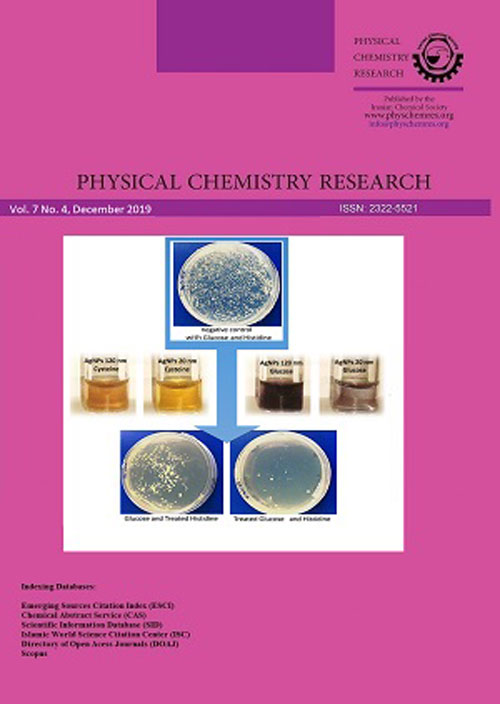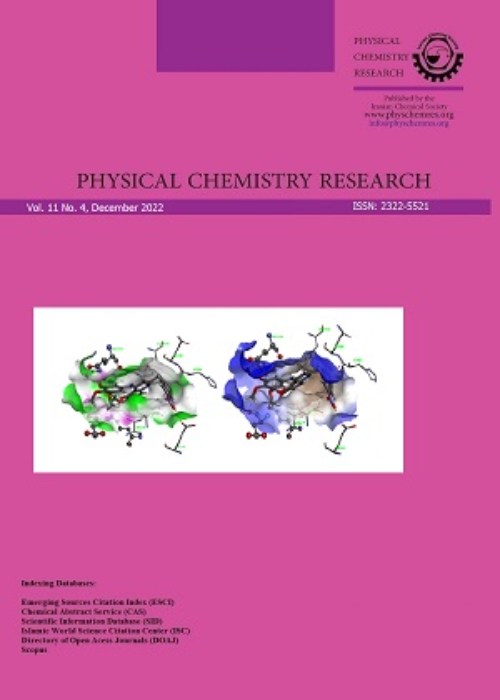فهرست مطالب

Physical Chemistry Research
Volume:9 Issue: 4, Autumn 2021
- تاریخ انتشار: 1400/05/03
- تعداد عناوین: 12
-
-
Pages 553-564
In this contribution, density functional theory-based calculations have been carried out to assess the electronic, photocatalytic and optical properties of Ce1-xTixO2 system. Ti incorporation leads to a decrease of Ce 4f states and enhancement of Ti 3d states in the bottom of conduction band. Furthermore, it was found that doping ceria with Ti-like transition metals could evidently shift the absorption of pure CeO2 towards higher wavelength range. These findings can provide some new insights for designing CeO2-based photocatalysts with high photocatalytic performance. To the best of our knowledge, this investigation calculates Mullikan’s charge transfer of Ce1-xTixO2 system for the first time. Charge transfer reveals an ionic bond between Ce or Ti and O, and covalent bonds between Ce and Ti atoms in the studies systems.
Keywords: Rare earth oxides (REOs), Cerium oxide (CeO2), Computational Modeling, Density functional theory (DFT), Density of states (DOSs), Ti-doping -
Pages 565-577
Adsorption experiments were carried out as part of the removal of Congo red (CR) as textile dye from aqueous solutions by using the powder of Cuttlefish bone (Sepia) as a new potential adsorbent. The prepared powder was characterized by FTIR, XRD, SEM, and elemental analysis. The effects of solution pH, adsorbent amount, CR concentration, temperature and contact time on the adsorption of CR studied were investigated. The experimental results showed that maximum pH was about 2 for efficient uptake of CR. The equilibrium was attained in 60 min. The adsorption of Congo red was exothermic in nature (ΔH° = 8.41 kJ/mol), while the positive value of entropy 20.85 J/mol.K indicated that the increasing randomness at the solid/liquid interface. The experimental data were analyzed using Langmuir and Freundlich isothermal models. The best fit was obtained by Langmuir model with a maximum monolayer adsorption capacity of 69.9 mg/g. adsorption kinetic data were properly fitted with the pseudo second-order kinetic model.
Keywords: Cuttlefish bone, Congo red, Removal dye, Kinetic, Isotherms -
Pages 579-590
The viscosities of binary mixtures of 1,4-butanediol with o-cresol, m-cresol and p-cresol have been determined at 303.15, 308.15, 313.15 and 318.15 K over the entire mole fraction range. The deviation in viscosity,, and excess Gibbs energy of activation (G*E) of viscous flow have been examined in terms of structural changes and interactions. The deviations/excess values were fitted to the Redlich-Kister equation to determine the fitting parameters and the root-mean square deviations. The results obtained for viscosity of binary mixtures were used to test the semi-empirical relations of Bingham, Frenkel, Kendall, HindUbbelhode, Refutas, Sutherland Wassiljiewa, Gambill, McAllister, Hind, Grunberg, Wijk, McAllister 4 body, Tamura Kurata, Katti-Chaudhri and Nhaesi.
Keywords: Viscosity, 1, 4-Butanediol, cresol, Excess Gibbs energy of activation, Viscosity relations -
Pages 591-603
Due to biodegradability and lower side-effects many sugar esters (SEs) have profound interest, and application in medicinal chemistry. In this respect, methyl 6-O-pentanoyl-α-D-galactopyranoside, obtained from methyl α-D-galactopyranoside (MDG) using direct site selective unimolar pentanoylation, was converted into four 2,3,4-tri-O-acyl esters reasonably in high yields. All the compounds were characterized well by spectroscopic techniques. Prediction of activity spectra for substances (PASS) indicated that these MDG esters have many potential biological activities especially the alkyl ester compounds had better antimicrobial potentiality than the sulphonyl ester compounds. Accordingly their ADMET predication indicated that most of the SEs has drug related good safety parameters. In this relation thermodynamic properties of the galactopyranosides are also investigated and reported herein.
Keywords: MEP, Methyl α-d-galactopyranoside esters, HOMO-LUMO, Sugar esters, Thermodynamic properties -
Pages 605-621
This research is a comparative study of the surface chemistry and adsorptive characteristics of titanium dioxide nanoparticles on activated carbon (Ac/TiO2) and chitosan loaded on activated carbon (Ac/TiO2/Ch). For the first time, using three-fold composite of activated carbon prepared from Persian mesquite seeds, chitosan, and nanoparticles of titanium dioxide as an effective adsorbent for removing safranin o. X-ray Diffraction (XRD), scanning electron microscope (SEM), BET analysis, and thermogravimetric analysis (TGA) have been used to determine and confirm physicochemical variation during preparing and modifying activated carbon on both adsorbents. The results of XRD, SEM, and TGA are shown essential changes happened in porosity of the surface after the modification process. The Ac/TiO2 and Ac/TiO2/Ch adsorbents have been used to /remove safranin o as a cationic azo dye from an aqueous solution. The experimental data at different conditions were correlated by some famous kinetic and isotherm models. Extrapolated data displayed dye adsorption on the Ac/TiO2, and Ac/TiO2/Ch follows the pseudo-second-order kinetic model. High efficiency and sufficient adsorption capacity in safranin o removal suggested that Ac/TiO2/Ch could be successfully used as a good candidate in water filtration.
Keywords: Activated carbon, TiO2NPS, Chitosan, Removal of Safranin o -
Pages 623-636
In the present research, the interaction of 3,4-methylenedioxy-N methylamphetamine (MDMA) drug with the pristine, Si, and Al-doped B12N12 nanocage, is investigated systematically using the density functional theory (DFT) method at B97D/6-31G(d) computational level. The obtained results show that MDMA drugs can be detected after interaction with pristine B12N12. Improvement in sensing properties of the desired nanocage is achieved after doping B atom of nanocage with Al or Si atoms. The uptake of the MDMA drugs prompts a substantial change in the energy gap (Eg) of the desired frameworks. The Si-B12N11 nanocage is a more proper sensor than the pristine and Al-doped B12N12 nanocage, considering significant changes in electronic properties and appropriate recovery time. The NBO analyses reveal that charge transfer occurs from the MDMA drug to the studied nanocages.
Keywords: DFT, Sensor, MDMA drug, B12N12 -
Pages 637-649
Two V/W-HMS (hexagonal mesoporous silica) nanostructures were synthesized with various vanadium and tungsten loadings. And their catalytic activities were investigated in oxidative desulphurization of dibenzothiophene (DBT) in model diesel fuel. The catalysts were characterized using X-ray powder diffraction (XRD), scanning electron microscopy (SEM), Fourier transform infrared (FT-IR) spectroscopy, and N_2 physical adsorption-desorption (BET/BJH) techniques. The best V/W-HMS catalyst exhibited high catalytic activity, capable of converting more than 95% of DBT in the model diesel fuel under the optimum reaction condition (0.05 gr 1:4 of catalyst, T=60°C, t=2h). After doping of vanadium with tungsten, it was found that bandgap of the catalyst was reduced and its catalytic performance was improved effectively. The catalytic activity remained unchanged even after 6 recycling processes. The reaction kinetics, mechanism, and bandgap energy of the catalysts were also investigated.
Keywords: Catalyst, Hexagonal mesoporous silica, Vanadium, Tungsten, DBT -
Pages 651-659
Fick diffusion coefficients are calculated by means of molecular simulation for liquid mixtures containing acetone, methanol and chloroform at 1 atm and 298 K for different compositions. For this means, Maxwell-Stefan (MS) diffusion coefficients were calculated using physical properties of the components and thermodynamic factors, Γ, using three different models of Wilson, NRTL and UNIQUAC. Because of the lack of experimental data for Fick diffusivities for ternary system, the validity of the model was tested by comparing Fick diffusivities obtained for binary subsystems with experimental data for acetone- chloroform system. The results were in good agreement. So the Fick coefficients, Maxwell-Stefan diffusion coefficient and the thermodynamic factors were predicted for the ternary mixture as well as its binary subsystems by molecular simulation in a consistent manner. The presented ternary diffusion data should facilitate the development of aggregated predictive models for diffusion coefficients of polar and hydrogen-bonding systems and allows for an efficient and consistent prediction of multicomponent Fick diffusion coefficients from molecular models.
Keywords: Fick diffusion coefficient, Maxwell-Stefan, Wilson, NRTL, UNIQUAC -
Pages 661-671
The surface tensions of pure refrigerants were predicted using a density gradient theory (DGT) coupled with a perturbed hard-sphere equation of state (EoS) approach. The EoS is taken from the Carnahan –Starling hard-sphere equation with the perturbation term of Dohm-Prausnitz (CS-DP EoS), in which the relevant parameters to the molecular size and energies are universal functions of temperature in describing the equilibrium bulk properties. Then DGT+CS-DP EoS model has been employed for predicting the surface tension of 26 pure refrigerants taken from a Chemistry Webbook provided by NIST. Our calculations on the surface tension data from the DGT+CS-DP model led to an average absolute deviation of 4.84%. Then, the degree of accuracy of DGT+CS-DP model has also been compared with other DGT-based model.
Keywords: Surface tension, Refrigerant, Density gradient theory, Equation of state -
Pages 673-688
Anticancer drugs bind with DNA nucleobase pairs (AT and GC) through different binding modes such as intercalation, groove binding, covalent binding etc. Quantum mechanical DFT method is quite useful for computing the interaction energy value for anticancer drug-DNA nucleobase complexes. In our study, we have taken some of the anticancer drugs to investigate the interaction energy for drug-DNA complexes. Among the different binding modes of anticancer drugs; minor and major groove binding in DNA base pair is also an important aspect for anticancer drugs; therefore some anticancer drugs may be minor groove specific and some may be major groove specific. Since, such sequence-specific experimental studies for drug-DNA nucleobase complexes are very complicated and hence this may be investigated by using quantum mechanical theoretical studies, using M062X basis set. Our studies reveal that the stacked models of anticancer drugs-DNA nucleobase (AT and GC) complexes always show negative interaction energy values and among all such complexes the most negative interaction energy value results the most stable and favoured stacked systems. The stacking interaction energies for anticancer drugs-DNA nucleobase (AT and GC) complexes can easily be reflected in the interaction of energy plots.
Keywords: Anticancer drugs, DNA nucleobase, AT, GC, DFT Methods, M062X etc -
Pages 689-700
This paper describes our interest on the ethanol separation and the enhancement of the obtained interaction parameters. The binodal curves and tie-lines data for the ternary systems (Water +Ethanol + 1-Octanol), (Water + Ethanol +4-Methyl-2-pentanone) and (Water + Ethanol + Ethyl Acetate) at 293.15K were investigated. These ternary systems follow a type-1 Liquid-Liquid equilibrium diagram. Furthermore, the extraction capabilities of these solvents in this study were tested using the separation factor (S) which was found greater than 1 in all ternary systems (S varying between 3.52 and 18.37). Besides, the values of the distribution coefficient (D) of ethanol were also not constant over the entire composition of the two-phase region (D values varied between 0.777 and 0.928), which confirms the extraction of ethanol. The ternary system (Water + Ethanol + Ethyl Acetate) was found to be the best option in terms of the distribution coefficient and separation factor. Othmer-Tobias and Hand plots have properly tested the reliability of the experimental tie-line data. In addition, non-random two-liquid model was used to correlate the experimental data, the model parameters were obtained using genetic algorithm, and there was a strong agreement between the experimental and calculated tie-lines with RMSD values below 1.72%.
Keywords: Liquid-liquid equilibrium, Ethanol, Cloud point, NRTL, Genetic Algorithm -
Pages 701-713
In this work, the Density Functional Theory (DFT) calculations, the Natural Bond Orbital (NBO) analysis, and the Hirschfeld surface analysis were carried out on the bis(4-cyanopyridine) [(meso-tetrakis(4-metoxyphenylporphyrinato)] iron (III) trifluoro-methane sulfonate chlorobenzene mono-solvate complex (I). The structure of the ferric porphyrin derivative (I) was optimized by using various quantum chemical methods HF, B3PW91, BPV86, and B3LYP with three bases set 3-21, 6-31 G (d, p), and 6-311 G (d, p). The theoretical structural parameters of (I) are very close to those obtained by X-ray molecular structure. From the optimized structure, several parameters such as the HOMO-LUMO energies, the dipole moments, the molecular electrostatic potentials, the Mulliken electronegativity, the chemical hardness, and the electronic potential were calculated and discussed. On the other hand, the absorption properties of (I) were obtained and compared with those obtained with the experimental UV-visible spectrum. The reactivity of our [FeIII (TMPP) (4-CNpy)2] + ion complex using various descriptors such as local softness, electrophilicity, electronegativity, hardness, HOMO-LUMO gap, were calculated and the Hirschfeld data of the crystal packing of (I) were discussed.
Keywords: Iron(III) porphyrin complex, DFT calculation, Natural bond orbital (NBO) analysis, Absorption properties, Hirshfeld surface analysis


